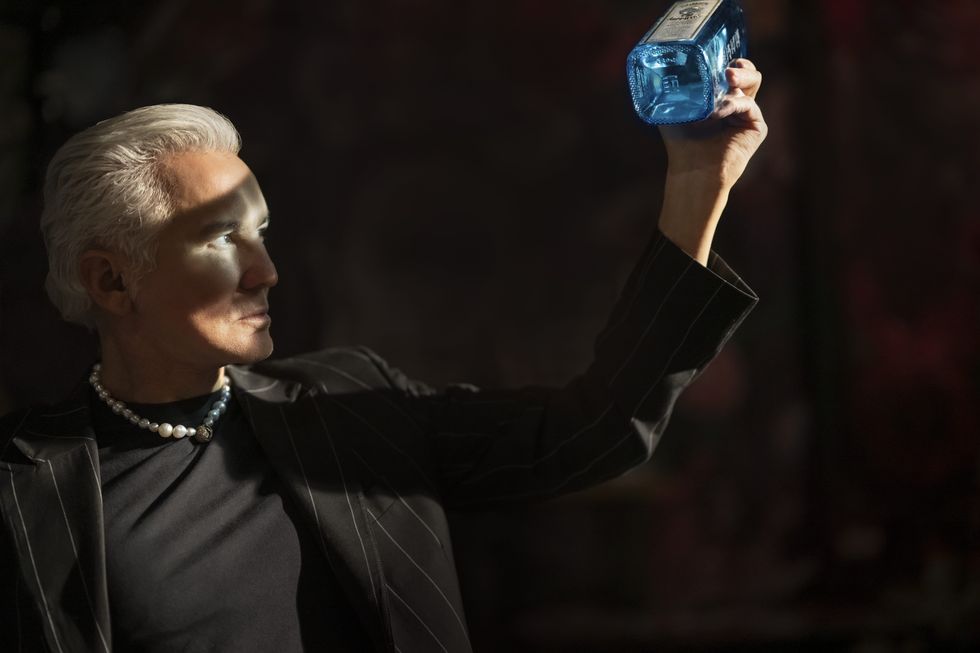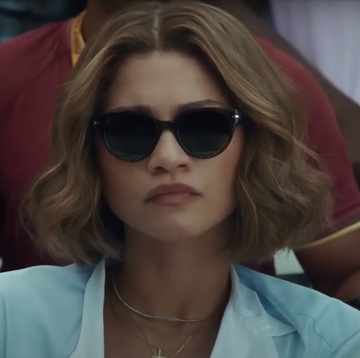Baz Luhrmann is living in the future, and we’re all getting left behind. Following nearly a year on the awards-season trail for Elvis, the 60-year-old Australian director already has a new project, one that pushes the boundaries of technology and traditional artistic methods. No, we’re not talking about getting JAY-Z and Beyoncé to collaborate on The Great Gatsby soundtrack, or having Elvis sing in a mashup with a Britney Spears track.
Luhrmann has set his sights on something even bigger—and very much in vogue—using AI to create new works of art. Recently, Luhrmann partnered with Bombay Sapphire on its "Saw This Made This" campaign, which encourages everyone around the world to find inspiration from their surroundings, asking people from around the world to submit creative inspiration from their daily lives to social media. Luhrmann curated a collection of those submissions to be displayed in an installation at the Design Museum in London on April 21, then at New York City's Chelsea Factory from May 11-13. Here's the fun, and potentially terrifying bit of it all: Luhrmann worked with a creative partner, Ai-Da, AKA the world's first hyperrealistic AI robot artist. Ai-Da will take inspiration from the submissions and create a live art piece in front of visitors. Don't worry—Luhrmann isn't buying into the Skynet of it all.
"I'm going into a session with Ai-Da today, and the press, they're all going to say, 'Aren't you scared that Ai-Da is going to replace us?'" Luhrmann tells me over Zoom. "But if I ask Ai-Da, 'Do you dream? Do you love?' And Ai-Da says to me, 'I've fallen in love and I can't stop. I do these crazy, ridiculous things. I've stopped painting because I keep pining after the coffee machine in the corner.' Then I'll be worried. But I don't think humanity can be replaced."
On a lovely spring day in London, before the opening of the installation, Luhrmann spoke about what it was like making art with AI, whether or not he's afraid Ai-Da will fall in love with him, and which classic story he might adapt next.
ESQUIRE: How are you doing, Baz?
BAZ LUHRMANN: Well, I'm great. I’m in London. It's the first moment of spring, so it's a bit like you're on mind-altering drugs. Everyone’s so happy because it's so pretty. We're finishing the exhibition here, which is really exciting. They've done a good job with the exhibit here at the London Design Museum. Tim Marlow, who's the [Director of the Design Museum], is a friend of mine, and they've really gone for it. We're also going to New York and bringing this exhibition to the Chelsea Factory.
Tell me a little more about the project—and what it's like working with Ai-Da, the AI artist robot.
I'm in a part of my journey where I really do believe everyone is creative. After going on the epic journey that has been Elvis, now I'm really going back to my creativity. I got completely swept up in this idea of doing an arts initiative. Now, we've had thousands of submission for the campaign—and there are some great creative gestures that have come out of it. Collaborating with AI, the Bombay Sapphire arts initiative, has gone to another level.
I met Aidan [Meller], this professor from Oxford, who built Ai-Da. He told me if the human brain has 80 trillion neuron parameters, Ai-Da's got 100 trillion—and soon that will double. It doesn't matter who you are, doesn't matter what you do, you cannot ignore AI. So this whole idea is about engaging with AI in a fun way. The proceeds of this installation are going to emerging artists. But let me tell you something: Is it great art? That's for the audience to decide. But what's really fascinating in engaging with her is—I am not scared of AI.
I have a bad idea of robots from all the sci-fi movies I've watched, you know?
In terms of politics and manipulation, yes, there's nefarious possibilities there. But in terms of art, AI might be able to create your favorite actor perfectly, but you need the actors on the set—because they create the human condition.
You're not worried that Ai-Da is going to fall in love with you?
Well, if she asks me on a date tonight, I'll let you know.
Part of the "Saw This Made This" campaign is about finding inspiration all around you. I'm curious what inspires your filmmaking process in your daily life.
When I get going on new projects, I go on a journey and think about what I need to deal with personally. But then I really look around me and go, OK, what's going on in the world? What could be useful? After Moulin Rouge, for example, I went on this big journey on the Trans Siberian, which was not glamorous. It’s a little tin box. At first, I was like, Oh my God, I'm on my own. How am I going to do this? Then I warmed up the room and got the wine out. I had an iPod with me. It was a new invention then, and on it was a book called The Great Gatsby. So I got inspired to make the movie by doing that journey.
I do these sort of quests. But when I'm making movies, my mind is always open. I was working in Miami, Florida, and I was trying to solve a problem in Romeo + Juliet. How do we surprise the audience when Romeo connects with Juliet? I go to the bathroom in this nightclub. When I come out, I'm washing my hands—and there's a fish tank. So where you wash your hands and comb your hair, I look through the fish tank. I can see a girl, combing her hair on the other side. And I go, That's the solution. It's like letting the back of your mind work, not in the foreground. So in the front of your head, you're doing the breakdowns, the analysis, the dramatic questions. But the back of the mind comes up with the imaginative solutions. Which is why I always make very romantic environments to create in, like my sets. I don't sit in white offices that have filing cabinets. They're covered in photographs. On Elvis, my entire office had all of his furniture. We built the jungle room [from Graceland]. I need to live it.
We're coming up on the ten-year anniversary of your The Great Gatsby adaptation. Do you have any thoughts about its legacy?
I love that. The book is a narrative inside the head of Nick Carraway. It's a very quiet book, but it's about a very loud, colorful, noisy, jazz age time. But in the film, I had to flip it. I had to show what was in Nick's head.
I lived it. There's not a square inch of Long Island that I don’t know. I hung out in Princeton with all the academics, but I also drank a lot of gin. One of the most moving and things that happened in my life was that after making Gatsby, I was asked to give the keynote speech at Princeton. F. Scott Fitzgerald never graduated from Princeton University, but I was down there so much that the family asked if I'd give the keynote speech at Princeton [2017 Class Day ceremony]. I was terrified of doing this. I mean, usually you're up against Oprah and Obama. So Scott Fitzgerald and I graduated in the same year together. When I was growing up, if you had told me in a tiny country town that that was going to happen, I would have said, "Probably not."
Are you interested in adapting any other classics? I'd love to see your version of The Picture of Dorian Gray, Dr. Jekyll and Mr. Hyde, or Brave New World.
Amazing that you mentioned Brave New World. Aldous Huxley, right? I knew his widow. George DiCaprio [Leonardo DiCaprio's father] was a great friend of his widow. There's parts of Brave New World that have never been released. You know what—with Dorian Gray? I agree with you. Wouldn't it be relevant now? Because aren't we all seeking the devil's bargain of eternal youth and beauty? So if I do it, will I have to give you a thank you credit at the end? I think I'll have to.
Just give me a ticket to see it and I'll be happy.
There are a few pieces that are floating around. I've got Faraway Downs coming, which is sort of like a variation on Australia. That's for Disney+. But I'm really excited about this art initiative right now. People are really coming forward with the art. The AI part of it is really engaging. I'm really surprised by how engaged I am with what it means. Then again, isn't the whole world completely engaged with AI right now? But soon I will have to go on my journey and go, OK, what can I put out in the world that's useful? Thanks for the pitches. Now you got me thinking.
I have to ask you, what's your favorite gin cocktail?
Look, I am going to be really boring, but I am an amazingly obsessed martini drinker. I actually judge a bar by how they make a martini—because martinis look simple, but they're not. Bombay is a really good gin for martini. I'm a gin martini guy. Pretty dry with a couple of olives.
Would you ever be interested in using AI during the filmmaking process?
Sure. It's already happening. I've seen stuff where AI is generating human faces. But what's not going to be replaced is the inner light of the characters. Absolutely I would use AI in the filmmaking process. We did a little tiny bit of it on Elvis. There's just one little moment in a montage where we used AI and blended Austin and Elvis's face in some of the film clips. Just a little tiny bit of it. But that's nothing. That was innovative five years ago. Every six months, it takes another exponential leap—and we've got to accept it. I do think there are things to worry about. But not creatively.
















